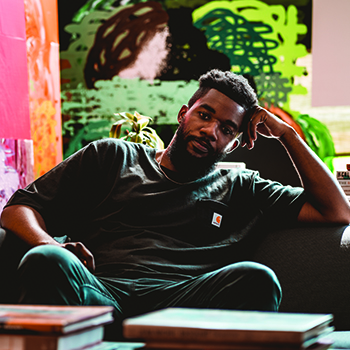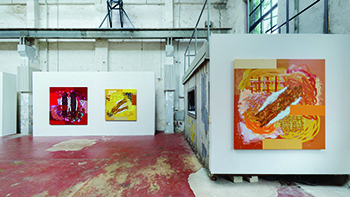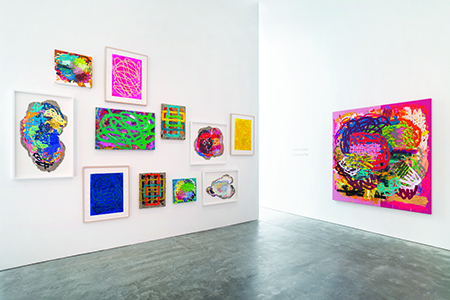
Art has always been a way for Patrick Alston ’13 to make sense of the world. The random decay of buildings of New York City, the disorder and trauma around him, and the fundamentals of art he learned at Wabash have created the foundation for the blooming career of a young artist.
Patrick Alston ’13 speaks in abstract.
“I appreciate the cross-cultural ties of abstraction and influences from around the world,” Alston says. “It was something that felt like a universal connector between generations, between cultures, it felt like something where my voice was most comfortable.
“I needed the experience at Wabash to learn the traditional focuses of painting,” he says. “But it gets really exciting when you break that mold and break into this language that has no bounds and is not necessarily tied to anything visually in our world.”
If size is volume, Alston’s giant works are loud.
“It is appropriate for the works to be in these grandiose scales. It makes it all encompassing,” he says. “I don't know if smaller works of mine have the same impact as larger works. I scaled up as I moved along in my art career, and it has felt great.”

Alston wants his art to start conversations.
“The most important thing for me is dialogue,” he says. “I don’t want people to view the works as dictating any message or beating across the heads of the viewer. I want the dialog to begin with either their appreciation or disdain for the work. I just want to start a conversation and have the works sort of live on their own.
“In many ways, the works are having conversations with audiences without me,” Alston continues. “Right now, I have a number of paintings in the world that are continuously having conversations with people. It’s just important to begin that conversation and contribute.”
GROWING UP IN THE BRONX, Alston spent hours in his room looking out the window and sketching what he saw.
“It was one of the ways I was able to understand the world around me and process thoughts,” he says. “I had a fascination for the environment. It was a challenge as well—something I wanted to perfect, call my own.”

Alston was recruited to Wabash from the Eagle Academy for Young men in the Bronx. Crawfordsville was different than anything he had experienced to that point.
“I appreciated the culture shock. Being at Wabash helped to diversify my experiences,” he says. “I only took one art class in high school. Wabash was the first time I was in the presence of a working artist like Professor Calisch. It was my first experience with stretching canvas, and I had my first easel. It was the introduction to what it means to be a fine artist. It was my introduction to the study of art, but also the rigors of the practice of being an artist.”
Emeritus Professor of Art Doug Calisch isn’t surprised by Alston’s success even though he came to Wabash with little artistic foundation.
“Patrick had an emotional need to paint. It was inside him,” Calisch says. “He came about knowing what he wanted to do by not doing what people told him to do. Every step of the way, he was defending his work, because it was different than what people had expected.”
 ALSTON’S WORK HAS BEEN part of group and solo exhibitions in galleries and museums around the world. Currently, the Harvey B. Gantt Center for African American Arts+Culture, in Charlotte, North Carolina, is hosting Alston’s first solo museum exhibition in the U.S. titled, “Post-Traumatism: In Search of Freedom.”
ALSTON’S WORK HAS BEEN part of group and solo exhibitions in galleries and museums around the world. Currently, the Harvey B. Gantt Center for African American Arts+Culture, in Charlotte, North Carolina, is hosting Alston’s first solo museum exhibition in the U.S. titled, “Post-Traumatism: In Search of Freedom.”
“I understand my position in the relay race of life—even if it’s me just passing this baton of an idea on, I’m continuing that race forward,” Alston says.
“My practice isn’t the same without an audience,” he continues. “Being able to present it in a museum feels full circle from when I was trying to figure everything out to finally getting an institution to open up the doors and say, ‘We would love to have a show with you.’ A lot of people call me young, but it feels like a long time coming. It also feels like it’s just the beginning.”